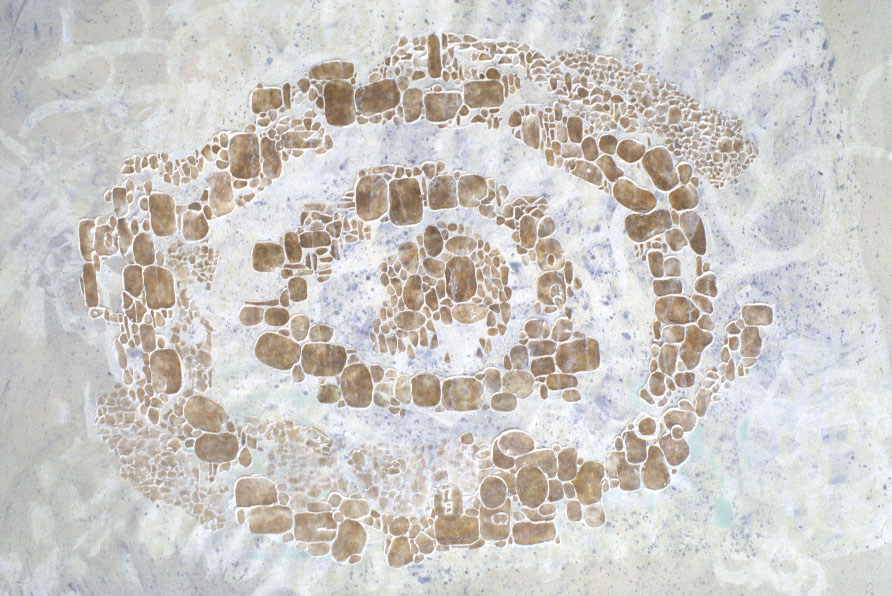 |
|
Perelandra,
58 x 85, 1999
|
Patricia Albers,"Out of the Earth", Museum of Art and History, Santa Cruz, 2002
In 1938 British writer C.S. Lewis published Out of the Silent Planet - allegorical novel, science fiction saga, and fuel for the creative imagination of painter Frank Galuszka. In Lewis' story, the kidnapped Dr, Ransom is taken hostage to the planet Malacandra. On landing in alien territory and finding himself surrounded by colors that at first "(refuse) to form themselves into things," he realizes he "(knows) nothing yet well enough to see it: you cannot see things till you know roughly what they are." When extraterrestrials materialize, Ransom perceives hideous bogy-men. Yet, as he begins to feel affection and respect for the creatures, they metamorphose into eye-pleasers. In Lewis's Neoplatonic lexicon, one perceives only the appearances of things, never the things themselves. Seeing is a complex process including intuition, memory, emotion, and analysis as much as visual stimuli; we must be wary of what our senses tell us. In probing the relationship between looking and understanding, Lewis stirs questions inherent in Galuszka's paintings. Painter Frank Galuszka, for his part, is pursuing not a new thing but a new relationship between his painting and reality. Schooled in Renaissance techniques (such as modeling and linear perspective) and mindful of the Renaissance idea of painting as an illusory window on the world, Galuszka has, over the years, produced an oeuvre that defies attempts at stylistic classification. An intense and restless artist who oscillates between figuration and abstraction, he spills onto his canvases brimming cornucopias of ideas, forms, and impastoed pigments. With the works exhibited here he firmly shuts the Renaissance's metaphoric window. His ambition: to narrow the gap between painting and reality, to create an image that interacts with the real world, to offer not a picture but rather something akin to "the thing itself." To do so, Galuszka employs several pictorial strategies. For instance, he makes his canvases large enough to be presences and sets up fields as dimensionless, diaphonous, and chromatically subtle as stirred sheens of golden dust. Seeking analogies for life's agitation and mutability, he blurs traditional figure-ground relationships, depicting half-forms that drift and quiver, always on the verge of submersion. As for the subject lurking within (as within all abstract art), it is indistinct and ambiguous in orientation and scale: cell clusters, perhaps, or sun-lit streambeds, archipelagos, moons or nebulae - or all of the above. Time insinuates itself through Perelandra's coils, for instance, suggesting calendrical spirals or star maps, and
what could be vestiges of antiquity in End of Rome or Delphi in Snow. Galuszka achieves his dazzling effects in part through the use of mica: he not only mixes powdered mica into his pigments but also glues mica chips (gathered outdoors or cut from commercially availabe sheets onto the canvases. In what the artist describes as an evolutionary process, these are arranged in glowing biomorphic clumps, which might them be painted, scraped, added to, and repainted. Realworld objects extracted from the earth, the chips are also, like the gold tesserae biomorphic clumps, which might them be painted, scraped, added to, and repainted. Realworld objects extracted from the earth, the chips are also, like the gold tesserae that encrust Byzantine mosaics, pools of immaterial light or, to rephrase poet Hart Crane's description of the sea, small winks of eternity. And their mirrored surfaces act as a feedback loop, a notion drawn from cybernetics, the science of complex systems that is Galuszka's conceptual framework for his artmaking. As such, they remind us of the dynamic interconnectedness of everything and establish reciprocity with the viewer who necessarily supplies a share of any work of art's meaning. Re-enter Dr. Ransom and the precarious, confounding, delightful matter of seeing.
-more -
© Frank Galuszka 2008
